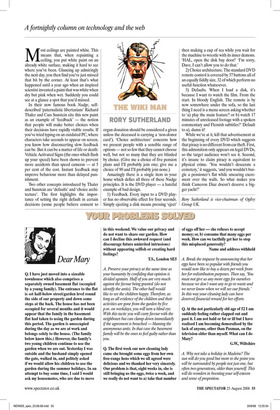M ost ceilings are painted white. This means that, when repainting
a ceiling, you put white paint on an already white surface, making it hard to see where you’ve been. Glancing up admiringly the next day, you then find you’ve just missed that bit by the corner. At least that’s what happened until a year ago when an inspired scientist invented a paint that was white when dry but pink when wet. Suddenly you could see at a glance a spot that you’d missed.
In their now famous book Nudge, selfdescribed ‘paternalistic libertarians’ Richard Thaler and Cass Sunstein cite this new paint as an example of ‘feedback’ — the notion that people will make better choices when their decisions have rapidly visible results. If you’ve tried typing on an outdated PC, where characters take seconds to appear on screen, you know how disconcerting slow feedback can be. But it can be a matter of life or death: Vehicle Activated Signs (the ones which flash up your speed) have been shown to prevent more accidents than speed cameras — at 5 per cent of the cost. Instant feedback may improve behaviour more than delayed punishment.
Two other concepts introduced by Thaler and Sunstein are ‘defaults’ and ‘choice architecture’. The first highlights the importance of setting the right default in certain decisions (some people believe consent to organ donation should be considered a given unless the deceased is carrying a ‘non-donor card’). ‘Choice architecture’ concerns how we present people with a sensible range of options — not so few that they cannot choose well, but not so many that they are blinded by choice. (Give me a choice of five pension plans and I’ll probably join one; give me a choice of 90 and I’ll probably join none.) Amazingly there is a single item in your home which defies all three of these Nudge principles. It is the DVD player — a hateful example of bad design.
1) Feedback. Every input to a DVD player has no observable effect for four seconds. Simply ejecting a disk means pressing ‘eject’ then making a cup of tea while you wait for the machine to wrestle with its inner demons. ‘HAL, open the disk bay door!’ ‘I’m sorry, Dave, I can’t allow you to do that.’ 2) Choice architecture. The standard DVD remote control is covered by 37 buttons all of an equally fiddly size, 32 of which perform no useful function whatsoever.
3) Defaults. When I load a disk, it’s because I want to watch the film. From the start. In bloody English. The remote is by now somewhere under the sofa, so the last thing I need is a menu screen asking whether to ‘a) play the main feature? or b) watch 17 minutes of unreleased footage with a spoken commentary and Flemish subtitles?’ Default to a), damn it!
While we’re at it, kill that advertisement at the beginning of every DVD which suggests that piracy is no different from car theft. First, this admonition only appears on legal DVDs, so the target audience won’t see it. Second, it’s insane to claim piracy is equivalent to physical crime. ‘You wouldn’t desecrate a cemetery,’ it suggests, ‘and you wouldn’t burgle a pensioner’s flat while smearing excrement over the walls. So what makes you think Cameron Diaz doesn’t deserve a bigger yacht?’


























































 Previous page
Previous page